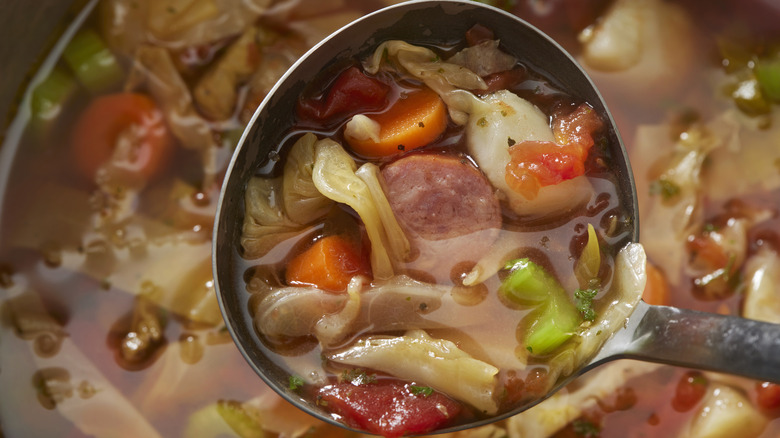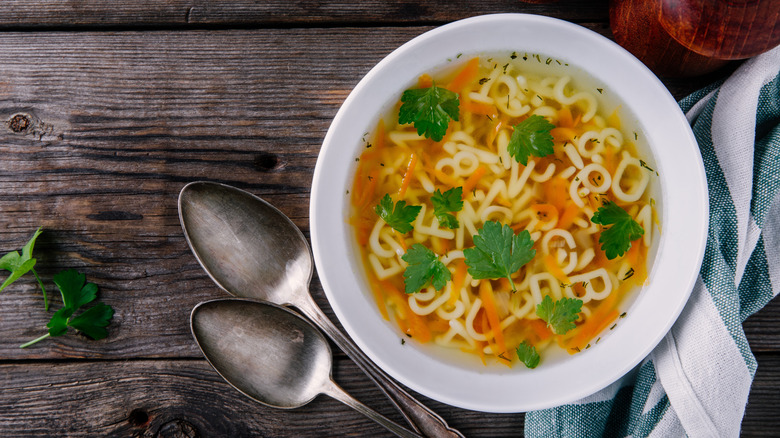The Tip You Need To Know To Maximize Flavor In Your Favorite Soup
While that canned soup can be convenient, the flavor is dramatically different from homemade. Even though your recipe may be passed down, a key tip might not be written in the instructions. The slow, simmering, all-day aroma might have been one factor, but the other key component happened way before the soup was ladled into the bowl.
Building on aromatics, herbs, and seasonings, the primary flavor is only as good as its foundation. But that flavor does not happen in an instant. The best tip for a more robust soup is to make the soup one day but serve it the next day. Instead of seeing it as a ladle of leftovers, consider the true cooking time to include an additional 24 hours.
Putting aside the hasted cooking in a pressure cooker or other kitchen appliance that quickens the process, a soup needs to simmer to extract all the ingredient's flavor. As the minutes turn to hours, the flavors develop. For example, noodles absorb broth, herbs, and seasoning. The longer the ingredients commingle, through both heating and cooling, the more flavors harmonize. That time spent in the fridge is just as vital as the time on the stove. More than unwanted fat rising to the top for easy removal, the cooling process intensifies the flavor. When the soup hits the stove for the second time, the robust flavor satisfies even more, which cannot be rushed for the sake of haste.
Is it science or love that makes soup taste better over time?
While some people argue that love is a secret ingredient in recipes, others believe that concept is limited to the fictional pages of "Como Agua Para Chocolate." Although cooking for someone can be a tangible expression of gratitude, the scientific components that transform raw ingredients into cooked ones create the flavor. Even without precise measurements, understanding the science of cooking can make for a more robust-tasting soup.
From the classic chicken noodle to a vibrant pea and ham variety, the proteins in the liquid need time to transform into that tender bite. Low, slow cooking allows the collagen to break down, which creates a more appealing texture. Anyone who has tried to chew a fibrous, tough protein can appreciate the unpleasant experience. When the food is cooked slowly, that tough exterior melts away to reveal a succulent bite, which is enjoyable to eat.
While the lengthened cooking time helps, the cooling period is equally important. Many people have come to appreciate the concept of resting meat prior to slicing to avoid all that flavor spilling onto the board. A similar concept applies to cooking and cooling soup. As the proteins cool, the ingredients contract to seal in all the surrounding flavors. When it hits the heat again, the fibers lengthen and assimilate into all the other ingredients. Even if it might seem counterintuitive with this back-and-forth process, one flavorful spoonful proves the concept.
Starches become flavor bomb treasures the longer soup cooks
While the old wives' tale about chicken noodle soup being the ailment cure-all might be followed in some kitchens, the combination of a robust broth with little flavor bomb treasures, those noodles, can make the day seem brighter. In order for those starches to shine, the slow cooking, cooling, and reheating process is beneficial.
The flavors meld as those noodles, rice, or potatoes submerge in the bubbling liquid. When removed from the heat, those ingredients act like sponges to sop up not just the extra liquid but the herbs and other seasonings in the dish. That potato in the clam chowder is not just a thickening agent; that chewable umami bite captures the briny, bright compilation of all the ingredients. If the process is rushed, that perfectly diced cube could be a bland note in an otherwise enjoyable dish.
Although the cooking, cooling, and reheating of soup might not be as precisely measured as baking science, appreciating how and why soup tastes better when allowed to hit the stove twice could change people's plans on when to start that dish simmering.


